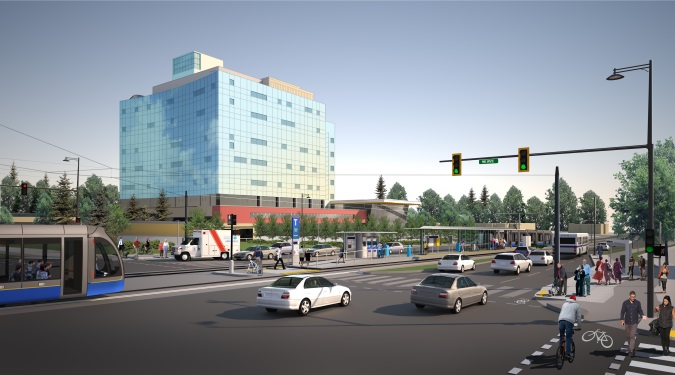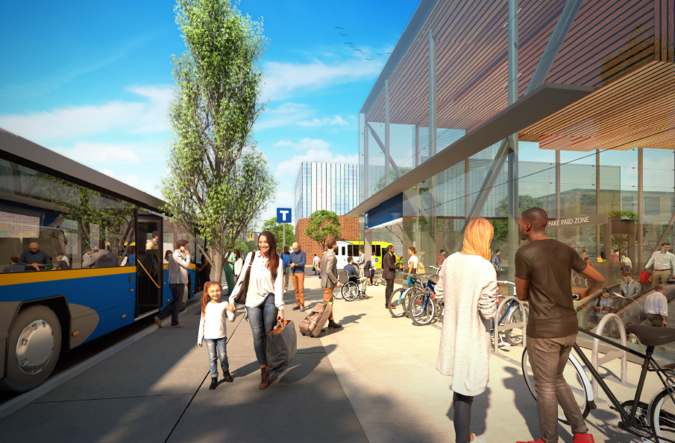10-Year Vision Spotlight – Building new rapid transit; new road, walking, cycling and new mobility investments; and HandyDART
10-Year Vision Spotlight – Building new rapid transit; new road, walking, cycling and new mobility investments; and HandyDART

This post is part of our 10-Year Vision Spotlight series, breaking down the nitty gritty of what’s planned in Phase Two of the Mayors’ Council’s 10-Year Vision!
UPDATE – Nov, 06, 2018: In light of the resolution passed by the City of Surrey council we are pausing work on the Surrey-Newton-Guildford LRT Project and suspending the RFQ process while we await direction from the Mayors’ Council and the TransLink Board. Read the full statement from TransLink CEO Kevin Desmond here.
If you’ve been following along on our Spotlight series, you’re likely aware that public engagement for Phase Two of the Mayors’ Council’s 10-Year Vision is taking place until May 11! This is your opportunity to get involved as we gather input to help develop and finalize the Phase Two Plan.
We’ve talked of the big changes coming to transit in Metro Vancouver, but arguably one of the biggest are the major rapid transit projects planned, including the Millennium Line Broadway Extension and the Surrey-Newton-Guildford Line.
The proposed Millennium Line Broadway Extension will extend the existing Millennium Line to Broadway in Vancouver. This is huge for Metro Vancouver as it will not only increase transit capacity, but will also decrease travel times, and help improve travel reliability in one of the busiest destination in our region.
Did you know: The Broadway corridor includes the largest hospital in western Canada, the second largest employment centre in British Columbia (UBC), and the busiest bus route in Canada and the United States (99 B-Line)?!
Beginning at VCC–Clark, the Millennium Line Broadway Extension will end at Arbutus Street and will consist of both elevated track as well as underground bored tunnel. On opening day the extension will include six new stations with trains expected to run every 3 – 4 minutes during peak periods, and every 6 – 8 minutes during off-peak periods. Moving 5,100 more passengers per hour per direction on opening day than the current 99 B-Line load equals a 250% increase in capacity! Plans for the extension allow for additional increases in capacity over time, as well as future rapid transit expansion to the UBC Point Grey campus.
The second element of building new rapid transit is the construction of the Surrey–Newton–Guildford Line. This new light rail line is the first stage of the South of Fraser Rapid Transit project, and will increase transit capacity, reduce commute times, and created integrated, pedestrian-friendly communities in two of Surrey’s busiest corridors.
The Surrey–Newton–Guildford Line will connect Guildford Exchange to Surrey Central Station via 104 Avenue, and connect Surrey Central Station to Newton Exchange via City Parkway and King George Boulevard. One of the many features of this line will be that all eleven new stations will be at street level allowing for more accessibility and easier connections to the community. Trains are expected to run every 5 minutes during peak periods, and every 7.5 minutes during mid-day and off-peak hours.
New Road Investments
Apart from public transit in Metro Vancouver, TransLink is also responsible for the region’s major road network. The Phase Two plan looks to increase funding for municipalities to pave roads, add lanes, fix bottlenecks, and upgrade overpasses and other structures to meet seismic standards.
New Walking, Cycling and New Mobility Investments
To round out the Phase Two Plan the proposal includes new investment in walking and cycling infrastructure across the region including an increase in funding for municipalities to construct new sidewalks and bikeways, as well as for TransLink to upgrade cycling infrastructure.
The New Mobility program was established in Phase One to leverage new technologies and business models for providing people with more mobility options.
HandyDART
The Phase Two Plan continues the increase HandyDART service across the region. HandyDART users can expect a 7% increase in service from 2020 to 2021
Want to learn more? Read the full discussion guide and take the survey at tenyearvision.translink.ca
Author: Sarah Kertcher











Really struggling to guess what station that is rendered, I’d like to say arbutus or Great Northern Way EUCAD, but also maybe oak or Granville, in fact, the only station I’d be sure that isn’t is Cambie City Hall
The LRT will NOT improve commuter times. A 1-2 minute decrease is not worth the $1.65 billion. Convert the 96 to a true BRT system and extend it to White Rock and Scottsdale.